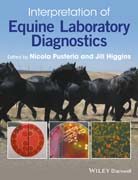
Interpretation of Equine Laboratory Diagnostics offers a comprehensive approach to equine laboratory diagnostics, including hematology, clinical chemistry, serology, body fluid analysis, microbiology, clinical parasitology, endocrinology, immunology, and molecular diagnostics. Offers a practical resource for the accurate interpretation of laboratory results, with examples showing real–world applications Covers hematology, clinical chemistry, serology, body fluid analysis, microbiology, clinical parasitology, endocrinology, immunology, and molecular diagnostics Introduces the underlying principles of laboratory diagnostics Provides clinically oriented guidance on performing and interpreting laboratory tests Presents a complete reference to establish and new diagnostic procedures Offers a practical resource for the accurate interpretation of laboratory results, with examples showing real–world applications Covers hematology, clinical chemistry, serology, body fluid analysis, microbiology, clinical parasitology, endocrinology, immunology, and molecular diagnostics Introduces the underlying principles of laboratory diagnostics Provides clinically oriented guidance on performing and interpreting laboratory tests Presents a complete reference to established and new diagnostic procedures INDICE: Preface .Chapter 1: Veterinary Diagnostic TestingLinda Mittel .Chapter 2: Basic Techniques and ProceduresEmir Hodzic .Chapter 3: Point of Care TestingC. Langdon Fielding .Chapter 4: Test PerformanceChristian M. Leutenegger .Chapter 5: EnzymesLeslie Sharkey .Chapter 6: Kidney Function TestsLeslie Sharkey .Chapter 7: CarbohydratesLeslie Sharkey .Chapter 8: LipidsM. Judith Radin .Chapter 9: Blood GasesAlonso Guedes .Chapter 10: ElectrolytesKrista E. Estell .Chapter 11: Miscellaneous SolutesLeslie Sharkey .Chapter 12: Cardiac TroponinDr. Anita Varga .Chapter 13: Vitamin and Mineral AssessmentCarrie J. Finno .Chapter 14: Toxicologic DiagnosticsRobert H. Poppenga .Chapter 15: Therapeutic Drug Monitoring K. Gary Magdesian .Chapter 16: Red Blood CellsJed Overmann .Chapter 17: LeukocytesJed Overmann .Chapter 18: PlateletsJed Overmann .Chapter 19: Blood Proteins and Acute Phase ProteinsJed Overmann .Chapter 20: Clotting times (aPTT and PT)SallyAnne L. Ness and Marjory B. Brooks .Chapter 21: AntithrombinSallyAnne L. Ness and Marjory B. Brooks .Chapter 22: Fibrin and Fibrinogen Degradation Products (FDPs)SallyAnne L. Ness and Marjory B. Brooks .Chapter 23: Coagulation FactorsSallyAnne L. Ness and Marjory B. Brooks .Chapter 24: Equine Infectious Anemia VirusSandra D. Taylor .Chapter 25: Equine Influenza VirusBeate Crossley and Ashley Hill .Chapter 26: Alpha–Herpesviruses (EHV–1, EHV–4)Beate Crossley and Ashley Hill .Chapter 27: Equine Rhinitis Viruses (ERAV, ERBV)Beate Crossley and Ashley Hill .Chapter 28: Interpretation of Testing for Common Mosquito Transmitted Diseases: West Nile Virus and Eastern and Western Equine EncephalitisMaureen T. Long and Kelli L. Barr .Chapter 29: Streptococcus equi ss equiAshley G. Boyle .Chapter 30: Corynebacterium pseudotuberculosisSharon J. Spier and Jennifer Jeske .Chapter 31: Neorickettisa risticiiSandra D. Taylor .Chapter 32: Anaplasma phagocytophilumJanet Foley and Nicole Stephenson .Chapter 33: Lawsonia intracellularisConnie J. Gebhart .Chapter 34: Borrelia burgdorferiAmy L. Johnson and Bettina Wagner .Chapter 35: Clostridium difficileK. Gary Magdesian .Chapter 36: Leptospira spp.Janet Foley and Mary H. Straub .Chapter 37: Fungal PathogensJill C. Higgins and Nicola Pusterla .Chapter 38: Sarcocystis neurona and Neospora hughesiAmy L. Johnson .Chapter 39: Babesia caballi and Theileria equiAngela Pelzel–McCluskey and Josie Traub–Dargatz .Chapter 40: Assessment of Vaccination Status and Susceptibility to InfectionW. David Wilson .Chapter 41: Immune–Mediated Hemolytic AnemiaJulia B. Felippe .Chapter 42: Equine Neonatal IsoerythrolysisJulia B. Felippe .Chapter 43: Immune–Mediated ThrombocytopeniaJulia B. Felippe .Chapter 44: Neonatal Alloimmune ThrombocytopeniaJulia B. Felippe .Chapter 45: Cellular ImmunityJulia B. Felippe .Chapter 46: ImmunoglobulinsJulia B. Felippe .Chapter 47: Equine Blood Groups and FactorsK. Gary Magdesian .Chapter 48: Bacteriology and Mycology TestingJoshua B. Daniels and Barbara A. Byrne .Chapter 49: Antimicrobial Susceptibility TestingK. Gary Magdesian .Chapter 50: Parasite Control StrategiesWendy Vaala and Robin Houston .Chapter 51: Molecular Diagnostics for Infectious PathogensNicola Pusterla and Christian M. Leutenegger .Chapter 52: Equine Genetic TestingCarrie J. Finno .Chapter 53: Genetic Tests for Equine Coat ColorM. Cecilia T. Penedo .Chapter 54: Peritoneal FluidJorge Nieto .Chapter 55: Respiratory SecretionsMelissa Mazan .Chapter 56: Pleural FluidMelissa Mazan .Chapter 57: Urine AnalysisLeslie Sharkey .Chapter 58: Synovial FluidJorge Nieto and Jan Trela .Chapter 59: Cerebrospinal fluidMonica Aleman .Chapter 60: Laboratory Testing for Endocrine and Metabolic DisordersNicholas Frank .Chapter 61: Endocrine Testing for Reproductive Conditions in HorsesAlan Conley and Barry Ball .Chapter 62: Foaling Predictor TestsGhislaine A. Dujovne and Camilla.J. Scott
- ISBN: 978-1-118-73979-2
- Editorial: Wiley–Blackwell
- Encuadernacion: Cartoné
- Páginas: 448
- Fecha Publicación: 04/12/2017
- Nº Volúmenes: 1
- Idioma: Inglés
- Inicio /
- /
